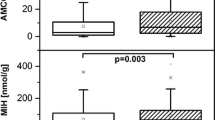Abstract
Objective: To investigate liver function in vinyl chloride workers and assess its relation with current/past occupational exposure to vinyl chloride monomer (VCM). Methods: A medical examination including the execution of liver function tests (LFTs) and liver ultrasonography was executed in a group of 757 workers with a long-standing service in the production of VCM/polyvinylchloride (PVC). Cumulative and maximum VCM exposures were calculated. History of viral hepatitis and alcohol intake were carefully investigated. Regression analysis explored the association between abnormal LFTs and a group of possible determinants (VCM cumulative and maximum exposure, BMI, age, history of viral hepatitis, alcohol and triglyceride levels). Also, synergistic effect between VCM and a history of hepatitis was analysed, as well as the possible association between VCM exposure and aspartate aminotransferase/alanine amino transferase (AST/ALT) ratio >1. Distribution of abnormal LFTs was also assessed in relation to the results provided by liver ultrasonography. Results: The most frequently abnormal serum parameters were, in decreasing order: total cholesterol (27.3%), triglycerides (12.2%), total bilirubin (9.1%), gamma glutamil transpeptidase (GGT; 9.0%) and ALT (8.2%). The AST/ALT ratio >1 was present in 28.1% of workers. Abnormal LFTs were not found to be associated with current or past VCM exposure. High ALT resulted positively associated with BMI, AST with alcohol intake, GGT with alcohol intake and triglycerides. No synergistic effect on LFTs of exposure to VCM and a history of hepatitis was observed. The AST/ALT ratio >1 was not found to be associated with VCM exposure. The prevalence of abnormal LFTs was higher in case of liver steatosis (ALT) or periportal fibrosis (GGT), but not in case of pure hepatomegaly, as documented by ultrasonography. Conclusions: Liver function assessment only including LFTs is not able to detect VCM-induced liver damage, but reveals alterations due to non-occupational factors, such as dietary and/or metabolic disfunctions. The LFTs are however of importance to detect conditions that could recommend avoidance of exposure to VCM and are useful for medical counselling and health promotion purposes.
Similar content being viewed by others
References
Cheng TJ, Huang ML, You NC, et al (1999) Abnormal liver function in workers exposed to low levels of ethylene dichloride and vinyl chloride monomer. J Occup Environ Med 41:1128–1133
Di Lorenzo L, Corfiati M, Bulfaro D, et al (2003) Il rapporto aspartato aminotransferasi (AST) e alanina aminotransferasi (ALT) nella sorveglianza sanitaria di lavoratori esposti a vinil cloride monomero: risultati preliminari. G Ital Med Lav Erg 25[Suppl]:109–111
Du CL, Wang JD (1998) Increased morbidity odds ratio of primary liver cancer and cirrhosis of the liver among vinyl chloride monomer workers. Occup Environ Med 55:528–532
Du CL, Kuo ML, Chang HS, et al (1995) Changes in lymphocyte single strand breakage and liver function of workers exposed to vinyl chloride monomer. Toxicol Lett 1995:379–385
Fauci AS, et al (eds) (1998) Harrison’s principles of internal medicine, 14th edn. McGraw–Hill, New York
Harris DK, Adams WGF (1967) Acroosteolysis occurring in men engaged in the polymerization of vinyl chloride. Brit Med J 3:712
Ho SF, Phoon WH, Gan SL, et al (1991) Persistent liver dysfunction among workers at a vinyl chloride monomer polimerization plant. J Soc Occup Med 41:10–16
Hsiao TJ, Wang JD, Yang PM, Yang PC, Cheng TJ (2004) Liver fibrosis in asymptomatic polyvinyl chloride workers. J Occup Environ Med 46:962–966
Hsieh HI, Wang JD, Chen PC, et al (2003) Synergistic effect of hepatitis virus infection and occupational exposures to vinyl chloride monomer and ethylene dichloride on serum aminotransferase activity. Occup Environ Med 60:774–778
Huang CY, Huang KL, Cheng TJ, et al (1997) The GST T1 and CYP2E1 genotypes are possible factors causing vinyl chloride induced abnormal liver function. Arch Toxicol 71:482–488
Lilis R, Anderson H, Nicholson WJ, et al (1975) Prevalence of disease among vinyl chloride and polyvinyl chloride workers. Ann NY Acad Sci 246:22–41
Makk L, Creech JL, Whelan JG, et al (1974) Liver damage and angiosarcoma in vinyl chloride workers. A systematic detection program. JAMA 230:64–68
Maroni M, Mocci F, Visentin S, Preti G, Fanetti AC (2003) Periportal fibrosis and other liver ultrasonography findings in vinyl chloride workers. Occup Environ Med 60:60–65
Pirastu R, Belli S, Bruno C, et al (1991) La mortalità dei produttori di cloruro di vinile in Italia. Med Lav 82:388–423
Sorbi D, Boynton J, Lindor KD (1999) The ratio of aspartate aminotransferase to alanine aminotransferase: potential value in differentiating nonalcoholic steatohepatitis fron alcoholic liver disease. Am J Gastroenterol 94:1018–1022
Sugita M, Masuda Y, Tsuchiya K (1986) Early detection and signs of hepatoangiosarcoma among vinyl chloride workers. Am J Ind Med 10:411–417
Taylor KJ, Williams DM, Smith PM, Duck BW (1975) Grey-scale ultrasonography for monitoring industrial exposure to hepatotoxic agents. Lancet 311:1222–1224
Author information
Authors and Affiliations
Corresponding author
Rights and permissions
About this article
Cite this article
Maroni, M., Fanetti, A.C. Liver function assessment in workers exposed to vinyl chloride. Int Arch Occup Environ Health 79, 57–65 (2006). https://doi.org/10.1007/s00420-005-0018-y
Received:
Accepted:
Published:
Issue Date:
DOI: https://doi.org/10.1007/s00420-005-0018-y




